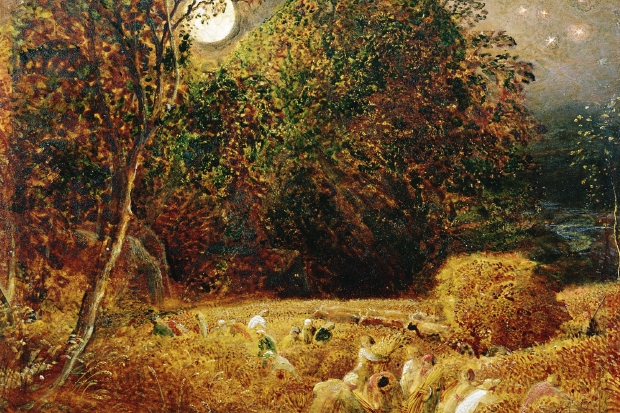In his youth, Samuel Palmer (1805–1881) painted like a Romantic poet. The moonlit field of ‘The Harvest Moon’ (1831–32) glows with uncanny significance; for Palmer, as for Tolstoy’s Lieven, the bowed forms of the peasants at the harvest are shadows of divinity. Palmer aged like a Romantic poet too. The long-haired mystic became a High Church Tory: like Coleridge, but without the drinking. ‘The Past for Poets, the Present for Pigs,’ was Palmer’s opinion of England after the Reform Act. But did the poetry of Palmer’s seven-year sojourn in the ‘Valley of Vision’ at Shoreham, Kent also decline into prosaic commerce and pastoral nostalgia?
In Samuel Palmer: Shadows on the Wall, William Vaughan, an expert on the painter, reminds us that our two Palmers were only ever one. Palmer was not a rebel hermit in his Shoreham period. He took to the woods in 1826 with a small inheritance, and returned to the city regularly, as Thoreau was to commute from Walden Pond to Concord. He worked with like-minded friends, including John Linnell, Edward Calvert and George Richmond, and secured a benediction from the ageing William Blake. The Palmer gang, like their German contemporaries the Nazarenes, styled themselves for the market: anticipating the self-publicising of the Pre-Raphaelites, the young idealists called themselves the Ancients.
Graham Sutherland called the early Palmer ‘a kind of English van Gogh’. In the valley of Shoreham, Palmer recalled, ‘the beautiful was loved for itself’. The luminosity is eccentric, not desperate. The later Palmer is a kind of English Claude Lorrain. The subject matter is stolid, the passions decorous, the effects controlled. But Palmer’s talent did not die on his 30th birthday. In 1832, having come into more money, he had bought himself a house in Lisson Grove. The Ancients were drifting apart: Richmond into portraiture, and Calvert into paganism. Palmer married John Linnell’s daughter Hannah, and settled in London.
Like Bob Dylan after his motorcycle crash, Palmer cut his hair and changed his voice. He became a successful producer of pastoral watercolours and etchings. The preliminary drawing for ‘A Pastoral Scene’ (1835) evokes the Shoreham years. The harvesters and their field are bleached by a ripe segment of moon, and a shepherd and his boy drive their flock through deep shadows. But the final oil, now in the Ashmolean, is restrained and muted. The moon is reduced to a sliver, the sheep are resting, and the shepherds are static in the long Arcadian twilight.
Time changed Palmer, not least through the premature death of his beloved son Thomas in 1861. Yet Vaughan detects a technical development alongside Palmer’s mugging by reality. The delicate son of a bookdealer, Palmer had received a spotty education. He had trained as a landscape painter, not in drawing, like Blake. The young Palmer was a highbrow primitivist, superimposing the cast shadow of Romantic painting onto the swains and brooks of the literary pastoral, creating the ‘mystic glimmer’ that Yeats, an admirer of the Ancients, misquoted or refashioned into a Celtic ‘misty glimmer’. Only later did Palmer complete his training. Like many autodidacts, he was educated back to front: as Blake left his Divine Comedy series unfinished, so Palmer left incomplete a translation and illustration of Virgil’s Eclogues. Palmer ended where he might have begun but, as Bob Dylan discovered, the trip was better than the destination.







Comments